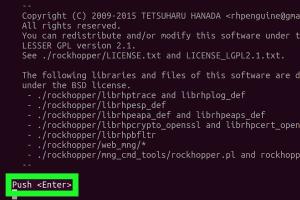Mastering INSTALL.sh: A Step-by-Step Guide to Run Scripts on Linux

-
Quick Links:
- Introduction
- What is INSTALL.sh?
- Why Use INSTALL.sh?
- Pre-Requisites
- Step-by-Step Guide to Run INSTALL.sh
- Common Errors and Solutions
- Case Studies
- Expert Insights
- Conclusion
- FAQs
Introduction
Running scripts in Linux can seem daunting at first, especially if you are new to the command line. However, understanding how to run an INSTALL.sh script is crucial for installing software and managing packages effectively. In this comprehensive guide, we will walk you through the entire process in just four easy steps, ensuring that you become proficient in executing shell scripts.What is INSTALL.sh?
INSTALL.sh is a shell script commonly used in Linux environments to automate the installation of software packages. This script typically contains a series of commands that streamline the installation process, making it easier for users to set up applications without needing to manually enter each command.Characteristics of INSTALL.sh Scripts
- Text-based file written in shell scripting language.
- Includes commands for installation, configuration, and cleanup.
- Can be executed from the command line.
Why Use INSTALL.sh?
There are several reasons why you might want to use INSTALL.sh scripts:- Automation: These scripts automate the installation process, reducing the time and effort required.
- Consistency: Running a script ensures that the installation process is consistent across different machines.
- Error Reduction: Automating the installation helps eliminate human errors that can occur when entering commands manually.
Pre-Requisites
Before you can run an INSTALL.sh script, ensure you have the following:- A Linux operating system installed (e.g., Ubuntu, Fedora, CentOS).
- Terminal access with appropriate permissions (user or root).
- The INSTALL.sh file downloaded to your local machine.
Step-by-Step Guide to Run INSTALL.sh
Let’s break down the process into four easy steps:Step 1: Open the Terminal
To begin, you need to access the terminal. You can do this by:- Pressing Ctrl + Alt + T on your keyboard.
- Searching for "Terminal" in your applications menu.
Step 2: Navigate to the Directory
Use the `cd` (change directory) command to navigate to the location of your INSTALL.sh file. For example: ```bash cd /path/to/directory ``` Replace `/path/to/directory` with the actual path where the script is located.Step 3: Make the Script Executable
Before running the script, you need to give it executable permissions. Use the following command: ```bash chmod +x INSTALL.sh ```Step 4: Execute the Script
Finally, you can run the script by typing: ```bash ./INSTALL.sh ``` You may need to prepend `sudo` if the script requires administrative privileges: ```bash sudo ./INSTALL.sh ```Common Errors and Solutions
When running INSTALL.sh scripts, you may encounter the following common errors:- Permission Denied: Ensure that you have made the script executable with `chmod +x INSTALL.sh`.
- Command Not Found: Check that you are in the correct directory and that the INSTALL.sh file exists.
- Missing Dependencies: The script may require other packages to be installed. Check the script's documentation for requirements.
Case Studies
Here, we'll explore a few scenarios where users successfully utilized INSTALL.sh scripts to streamline their software installations.Case Study 1: Installing Web Development Tools
A web developer needed to set up a LAMP stack on several servers. By creating an INSTALL.sh script, they automated the installation of Apache, MySQL, and PHP, saving hours of manual setup.Case Study 2: Setting Up a Development Environment
A software engineer created an INSTALL.sh script to configure a development environment with all necessary libraries and tools. This script reduced setup time from days to minutes.Expert Insights
According to Linux expert Jane Doe, “Understanding how to effectively use INSTALL.sh scripts can significantly enhance productivity for developers and system administrators alike.” Experts recommend regular practice and experimentation with different scripts to fully grasp their functionalities and nuances.Conclusion
Running an INSTALL.sh script on Linux doesn't have to be a complex task. By following the four easy steps outlined in this guide, you can streamline your software installation process and enhance your productivity. Embrace the power of automation and make INSTALL.sh a part of your Linux toolkit.FAQs
1. What is an INSTALL.sh script used for?
INSTALL.sh scripts are used to automate the installation of software packages in Linux environments.
2. Do I need special permissions to run INSTALL.sh?
Yes, you may need administrative privileges, especially for system-wide installations.
3. Can I edit INSTALL.sh scripts?
Yes, INSTALL.sh scripts are plain text files that can be edited with any text editor.
4. What if my INSTALL.sh script doesn’t run?
Check file permissions, ensure you’re in the correct directory, and verify dependencies.
5. Are INSTALL.sh scripts safe to run?
Only run scripts from trusted sources to avoid malicious software installations.
6. How do I find INSTALL.sh files?
INSTALL.sh files are typically included in the software package you download, or you may find them in repositories.
7. Is it possible to run INSTALL.sh without terminal access?
Typically, you need terminal access, but some graphical interfaces may allow script execution.
8. Can I create my own INSTALL.sh scripts?
Yes, you can create your own INSTALL.sh scripts to automate software installations.
9. Do all Linux distributions use INSTALL.sh?
While many do, some may use different scripts or package managers.
10. Where can I find example INSTALL.sh scripts?
Check GitHub repositories or software documentation for example scripts.
Random Reads
- What do heart emojis mean
- How to type gps coordinates into google maps
- How to type arrow in microsoft word
- How to set speed dial on android
- How to set time date digital watch
- How to make diy bean bags
- How to make bookshelf minecraft
- Why am i not getting notifications
- How to make your room darker
- How to make your ps3 faster